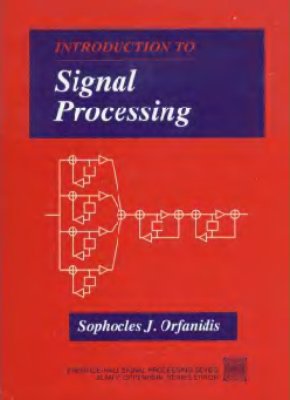Издательство Prentice Hall, 1996, -817 pp.
Tills book provides an applications-oriented introduction to digital signal processing written primarily for electrical engineering undergraduates. Practicing engineers and graduate students may also find it useful as a first text on the subject, Digital signal processing is everywhere. Today's college students hear "DSP" all the time in their everyday life-from their CD players. to their electronic music synthesizers, to the sound cards in their PCs. They hear all about "DSP chips", "oversampling digital filters", "I-bit AID and D/A converters", "wavetable sound synthesis", "audio effects processors", "all-digital audio studios". By the time they reach their junior year, they are already very eager to lea more about DSP.
Approach
The leaing of DSP can be made into a rewarding, interesting, and fun experience for the student by weaving into the material several applications, such as the above, that serve as vehicles for teaching the basic DSP concepts, while generating and maintaining student interest. Tills has been the guiding philosophy and objective in writing tills text, As a result, the book's emphasis is more on signal processing than discrete-time system theory, although the basic principles of the latter are adequately covered. The book teaches by example and takes a hands-on practical approach that emphasizes the algorithmic, computational, and programming aspects of DSP, It contains a large number of worked examples, computer simulations and applications, and several C and MATLAB functions for implementing various DSP operations. The practical slant of the book makes the concepts more concrete,
Use
The book may be used at the junior or senior level. It is based on a junior-level DSP course that I have taught at Rutgers since 1988. The assumed background is only a first course on linear systems. Sections marked with an asterisk (*) are more appropriate for a second or senior elective course on DSP. The rest can be covered at the junior level. The included computer experiments can form the basis of an accompanying DSP lab course, as is done at Rutgers. A solutions manual, which also contains the results of the computer experiments, is available from the publisher. The C and MATLAB functions may be obtained via anonymous FTP from the Inteet site ece.rutgers.edu in the directory /pub/sjo or by pointing a Web browser to the book's 'VIVIV home page at the URL ftp://ece.rutgers.edu/pub/sjo/int:ro2sp.html, or, http://www.ece.rutgers.edu/~orfanidi/intro2sp.html.
Sampling and Reconstruction.
Quantization.
Discrete-Time Systems.
FIR Filtering and Convolution.
z-Transforms.
Transfer Functions.
Digital Filter Realizations.
Signal Processing Applications.
DFT/FFT Algorithms.
FIR Digital Filter Design.
R Digital Filter Design.
Interpolation. Decimation, and Oversampling.
Appendices.
Tills book provides an applications-oriented introduction to digital signal processing written primarily for electrical engineering undergraduates. Practicing engineers and graduate students may also find it useful as a first text on the subject, Digital signal processing is everywhere. Today's college students hear "DSP" all the time in their everyday life-from their CD players. to their electronic music synthesizers, to the sound cards in their PCs. They hear all about "DSP chips", "oversampling digital filters", "I-bit AID and D/A converters", "wavetable sound synthesis", "audio effects processors", "all-digital audio studios". By the time they reach their junior year, they are already very eager to lea more about DSP.
Approach
The leaing of DSP can be made into a rewarding, interesting, and fun experience for the student by weaving into the material several applications, such as the above, that serve as vehicles for teaching the basic DSP concepts, while generating and maintaining student interest. Tills has been the guiding philosophy and objective in writing tills text, As a result, the book's emphasis is more on signal processing than discrete-time system theory, although the basic principles of the latter are adequately covered. The book teaches by example and takes a hands-on practical approach that emphasizes the algorithmic, computational, and programming aspects of DSP, It contains a large number of worked examples, computer simulations and applications, and several C and MATLAB functions for implementing various DSP operations. The practical slant of the book makes the concepts more concrete,
Use
The book may be used at the junior or senior level. It is based on a junior-level DSP course that I have taught at Rutgers since 1988. The assumed background is only a first course on linear systems. Sections marked with an asterisk (*) are more appropriate for a second or senior elective course on DSP. The rest can be covered at the junior level. The included computer experiments can form the basis of an accompanying DSP lab course, as is done at Rutgers. A solutions manual, which also contains the results of the computer experiments, is available from the publisher. The C and MATLAB functions may be obtained via anonymous FTP from the Inteet site ece.rutgers.edu in the directory /pub/sjo or by pointing a Web browser to the book's 'VIVIV home page at the URL ftp://ece.rutgers.edu/pub/sjo/int:ro2sp.html, or, http://www.ece.rutgers.edu/~orfanidi/intro2sp.html.
Sampling and Reconstruction.
Quantization.
Discrete-Time Systems.
FIR Filtering and Convolution.
z-Transforms.
Transfer Functions.
Digital Filter Realizations.
Signal Processing Applications.
DFT/FFT Algorithms.
FIR Digital Filter Design.
R Digital Filter Design.
Interpolation. Decimation, and Oversampling.
Appendices.

